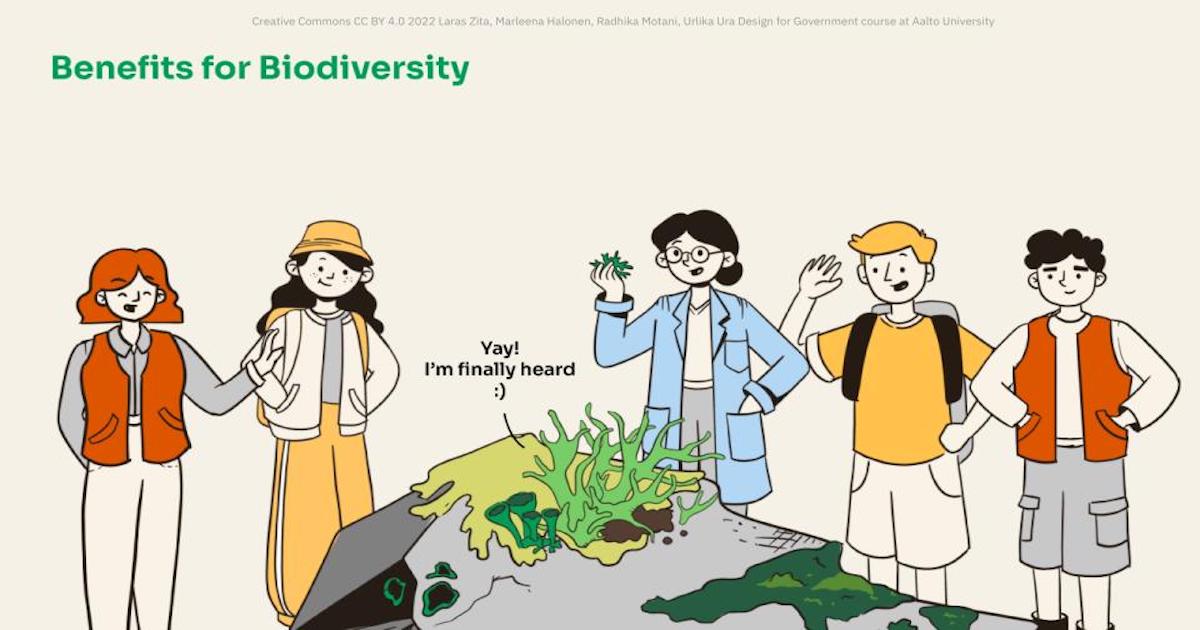This blog post reports on work-in-progress within the DfG course! The post is written by group 1A dealing with Metsähallitus and the Ministry of the environment’s brief on Sustainable nature recreation. The group includes Marleena Halonen, Radhika Motani and Zita Tedjokusumo from the Creative Sustainability program, and Ulrika Ura from the International Design Business Management program.
Written by: Marleena Halonen

The four phases of the Nuuksio Collaboratory program. Graphic design by Zita Tedjokusumo.
In this blog, I’ll describe the thinking process towards our final proposal the Nuuksio Collaboratory. It is a one-year program where visitors of Nuuksio National Park participate in a citizen science project led by Metsähallitus scientists to co-create solutions for the local biodiversity loss.
The threat to biodiversity in Nuuksio is mostly the visitor footprint – literally. However, our aim throughout the process was to see the visitors not only as objects of prevention but as potential collaborators in solving the problem related to themselves.
I had learned from courses in environmental policy, that the agent who is seen as harmful might be more willing to comply with regulations if they have been a part of the process of negotiating the guideline. (Ostrom 2015, 177; Ostrom, 1990). Building on this, we wanted to enable visitors to contribute to designing the park’s policies. Ostrom also highlights the practical knowledge of the ground-level agents, and accordingly, we wanted to acknowledge the creative potential of a visitor as an expert on visiting. One of the most significant sources of inspiration for Nuuksio Collaboratory was actually provided by Metsähallitus with the “Year of the Fish 2021” campaign, where recreationists had sent Metsähallitus ”dozens of tips on how everyone can promote the cleanliness of fishing waters and the welfare of fish.” (Metsähallitus 2021, 77). We were curious: With the right platform to foster co-creation on a broader level, what would be the potential?

We were filled with ideas when visiting the park as design students. Graphic design by Zita Tedjokusumo.
As our goal was set beyond human-centredness to biodiversity-centredness, visitor participation would only make sense, if it would be based on accurate observations with scientific knowledge on biodiversity. Luckily, the problem was tackled by discovering the Citizens Science practice, which means ”volunteer collection of biodiversity & environmental information which contributes to expanding our knowledge of the natural environment, including biological monitoring and the collection or interpretation of environmental observations.” (Tweddle et al., 2012). This could mean for example citizens taking part in data gathering and monitoring by collecting samples or documenting species as a part of scientific research. Our idea was to marry citizens’ science research with a platform in which visitors would generate solutions for the specific issue at hand. In addition, the initiative to call for visitors to help with the problem would also work as communication for raising awareness among visitors. You might want to behave more mindfully in the park if you have learned through posters that there are groups of people who are trying to solve these problems.
We had finally found our pieces for Nuuksio Collaboratory! Educated, creative visitors as collaborators to scientists in preserving Nuuksio biodiversity. We feel that we succeeded in reaching our goal using human-centredness towards biodiversity-centredness.
References:
Ostrom, Elinor. 1990. Governing the commons: The Evolution of Institutions for Collective Action. New York: Cambridge University Press.
Elinor Ostrom and the Bloomington School of Political Economy : Resource Governance, edited by Daniel H. Cole, and Michael D. McGinnis, Lexington Books, 2015.
Tweddle, J.C., Robinson, L.D., Pocock, M.J.O. & Roy, H.E (2012). Guide to citizen science: developing, implementing and evaluating citizen science to study biodiversity and the environment in the UK. Natural History Museum and NERC Centre for Ecology & Hydrology for UK-EOF.
Metsähallitus (2021). Sustainability Report. https://julkaisut.metsa.fi/assets/pdf/mh-vuosittaiset/mhannualreport2021.pdf
The DfG course runs for 14 weeks each spring – the 2022 course has now started and runs from 28 Feb to 23 May. It’s an advanced studio course in which students work in multidisciplinary teams to address project briefs commissioned by governmental ministries in Finland. The course proceeds through the spring as a series of teaching modules in which various research and design methods are applied to address the project briefs. Blog posts are written by student groups, in which they share news, experiences and insights from within the course activities and their project development. More information here about the DfG 2022 project briefs.


That’s a good article, this information so helpful for me. Thanks for sharing this informative blog post.